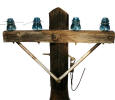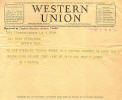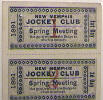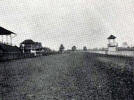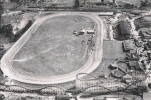|
Henry
A. Montgomery |
|
...and
the
Historic Montgomery Park |
|
|
|
At the turn
of the century Memphis was home to a race track named Montgomery
Park. It was located on the outskirts of town, and had a
small grandstand.
The races here regularly attracted spectators from all walks of life and
from all the surrounding states. You would find the upper-crust from
"Victorian Village” standing shoulder to shoulder with the country
folks from Arkansas. The man behind this lively track was Memphian
Henry A. Montgomery. He had formed the Memphis Jockey Club and
by the 1850s the club purchased a tract of land that would become the Fairgrounds,
and built their track.
During
the late 1800’s there was good attendance at the races and lively betting with regular articles
featured in the New York Times reporting the
goings-on. The "Tennessee Derby" was run there in 1884-1886 and
again from 1890-1906. And it actually rivaled the Kentucky Derby
for gambling and excitement. This is the story of Henry A.
Montgomery and his race track. |
 |
| |
|
|
|
|
|
Click on Small
photos to enlarge them |
|
|
|
|
|
|
|
|
|
 |
Henry Arthur Montgomery was born in Fermanagh County, Ireland in
1829. At fifteen he began an apprenticeship with Thomas Karnahan
& Sons, a timber, state and iron dealership. He immigrated to
Canada in the Spring of 1848 and moved later that year to Brown
County, Ohio. By the time he applied for U.S. citizenship in
1851, he had married Maria Jane Dugan, a native of Ohio. The
young family moved to Tennessee shortly after the birth of their
daughter Julia, the first of Henry and Maria's six children. |
| Fermanagh
County, Ireland |
|
|
|
|
|
Julia Montgomery, born in
1851, married Decatur Doyle. Annie Dugan Montgomery died as a child.
Lulu Montgomery, born in 1856, married Dr. Robert Jones, Jr. Jennie
Montgomery married Dr. Kennedy Jones. Elizabeth "Bessie" Montgomery
married Robert Thaddeus Cooper. The Montgomery's only son, Stonewall
R. Montgomery was born in 1863. |
|
|
 |
 |
 |
 |
 |
 |
 |
| Maria Jane
Dugan |
Julia |
Annie
|
Lulu |
Jennie
|
Elizabeth"Bessie" |
Stonewall |
|
|
|
| |
| |
| |
|
The Montgomery's lived a short time in Somerville, TN, before settling
in Memphis, where Henry began working in the telegraph business.
His early efforts involved direct control of all phases of the
introduction of telegraphic communications into the Memphis area, but
by the late 1850s, he was dealing primarily with the construction of
telegraph lines. He built the first telegraph line from Memphis
to Little Rock, and during the Civil War he extended it to
Clarksville. In addition, he built a line from Madison to
Helena, Arkansas. |
 |
| |
|
|
|
|
|
|
|
The
telegraph was similar to many other inventions of the time. It
replaced an existing technology, dramatically reduced costs, was
monopolized by a single firm, and was ultimately displaced by a newer
technology. The basic science of the telegraph is to send
an electric current through a wire. It was invented by
Samuel Morse and with it came the Morse Code which allowed for
breaking the electrical current in a particular pattern which denoted
letters or phrases. It's still used today. Morse patented the
telegraph in 1838. Royal House and Alexander Bell introduced rival
patents in 1846 and 1849, and the rivalry began. By 1866
Western Union absorbed its last competitors and achieved market
dominance. And then the real threat came from Alexander Graham Bell's
1876 invention of the telephone or "talking telegraph".
|
 |
| |
Vintage Telephone |
|
|
|
|
|
|

Montgomery Place |
The Henry A. Montgomery home
"Montgomery Place" was
built in the 1860's and was
located at Poplar
and Bellevue. The beautiful home was the site of many grand and lavish
parties, including an 1882 reception for Oscar Wilde. The home was
razed in 1938 when William R. Moore needed space to build
his school. Many sources state that the home was
demolished when the next door Tech High School was built across the
street, but recent
research verifies that it was the William R. Moore School.
Early
Memphis Directories list the location of the home as "Poplar
NE corner of Mhoon Av (The name Mhoon Av was changed to Bellevue
around 1900). The
first, and at the time, the only telephone in Memphis was installed in
Henry A. Montgomery's home.
When the first
telephone call was made in Memphis, it was from the railway office of
Col Michael Burke to the home of Henry A. Montgomery on Poplar
Avenue. |
|
|
|
|
|
|
|
|
|
|
|
|
|
After leaving the telegraph business,
Montgomery explored other ventures, including lumber, dry goods and cotton
speculation. His many achievements in business brought prosperity and
social recognition to him and his family. By the mid 1860s, the
Montgomery's had become a part of the social elite of Memphis and had
earned a reputation for being hospitable and concerned about community
affairs. After his wife Maria's death in 1870, Montgomery continued
to be active in the civic and business affairs of Memphis. He was
elected Fire and Police Commissioner in 1884.
When it came to "cotton speculation", he hit it big time, becoming founder
and President of the Merchants' Cotton Press and Storage Company.
The Cotton Press was a major invention which eliminated the need for all
the gigantic storage sheds. This invention could compress cotton
bales to 1/3 their original size. And a daily compress output was six
thousand bales. (In 1887, prominent Memphian Napoleon Hill succeeded
founder Henry Montgomery, as head of the Merchants' Cotton Press and
Storage Company). |
|
|
|
|
|
|
|
|
|
The Memphis Jockey Club ... |
|
|
 |
Henry A. Montgomery formed
The
Memphis Jockey Club in 1836 and the meetings were originally held
at a location on Mississippi Boulevard. By the early 1850's the
Jockey Club had purchased land and established a race track, and named its principal race of the year
the Tennessee Derby. Montgomery served as president of the
Memphis Jockey Club and was also the principal promoter and financial
investor in the race track. It was
inevitable that the race track would be named "Montgomery Park". |
|
The Club House |
|
|
|
|
|
|
|
|
 |
 |
 |
 |
 |
 |
| 1897 Lapel Pin |
Vintage Pomade |
Vintage Hair Dressing |
Vintage Powder |
1901 Pin |
Pin |
|
|
|
|
|
|
Montgomery Park Race Track ... |
|
|
|
Montgomery Park Race Track
was an American
thoroughbred racetrack in
Memphis - with gambling. |
|
|
 |
In 1851
land was purchased out of the 5000 acre Deaderick Plantation and
developed as a horse-racing track by the Memphis Jockey Club. The
track was reorganized in 1882 and named Montgomery Park . During the
late 1800’s there was good attendance and lively betting at the
Memphis track, with regular articles in the New York Times reporting
the goings-on. The Tennessee Derby was run there in 1884-1886
and again from 1890-1906, and rivaled the Kentucky Derby for gambling
and excitement.
The
track consisted of a one mile dirt oval 65 feet wide at all points. |
| 1903
Grandstand |
|
|
|
|
 |
 |
 |
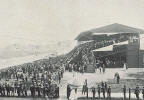 |
|
Vintage Crowd |
1892 Montgomery Park |
1916 Montgomery Park |
Vintage Race |
|
|
|
The Tennessee
Derby was an
American
Thoroughbred horse race that was run annually from 1884 to 1886 and then
1890–1906 at the
Montgomery Park Race Track
located on what became the Memphis Fairgrounds. It rivaled the
Kentucky Derby
at the time for prestige and purse money. Kentucky Derby winners
Joe Cotton
and
Agile
had won at the Tennessee Derby. On race days the crowds in the park
might total 25,000 people, including important "visitors" from New
York or Washington D. C.. |
 |
|
|
1904 C. Vanderbilt |
|
|
|
 |
 |
 |
 |
 |
 |
|
1896 Article |
1889 Article |
1889 Article |
1901 Article |
1901 Article |
1902 Article |
|
|
|
|
|
|
|
|
The
principal races were the Gaston Stakes, restricted to 2 year olds, for a
prize of $500, and the Peabody Stakes which was for 3 year olds, also with
$500 in added prize money. A supporting race was the Open Gayoso
Stakes, while there was also variety offered in the Handicap Steeplechase.
The track was very popular and very successful. |
|
|
|
|
|
|
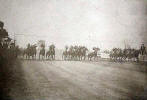 |
But the Tennessee legislature
outlawed gambling in 1906 and the track ran its last race and closed
Montgomery Park. Following the closure, the track land and facilities were first leased and
then purchased by the city of Memphis and eventually incorporated into the
Tri-State Fairgrounds and later into the Mid-South
Fairgrounds.
|
 |
|
1905 Race |
|
|
1905 Race |
|
|
|
|
|
|
|
| |
|
Track records
for Montgomery Park at various distances. |
|
|
|
Distance |
Horse |
Age |
Weight |
Date |
Time |
|
1/2
mile |
Rose
Dele Strome |
3
2 |
100
101 |
04/09/1887
05/07/1906 |
:49 |
|
41/2
furlongs |
Sainrida
Montgomery |
2
2 |
115
113 |
05/05/1906
05/09/1906 |
:55
1/4 |
|
5/8
mile |
Horace E. |
2 |
118 |
05/07/1906 |
1:01
1/4 |
|
51/2
furlongs |
Toah
Nannie Hodge |
4
4 |
107 1/2
106 |
04/16/1902
04/17/1905 |
1:08
1/4 |
|
3/4
mile |
Waring |
5 |
129 |
04/23/1902 |
1:14 |
|
7/8
mile |
Triaditza
The Rush |
3
3 |
86
102 |
04/14/1900
04/28/1900 |
1:27
3/4 |
|
71/2
furlongs |
Elsie L. |
4 |
105 |
04/18/1903 |
1:34
1/2 |
|
1 mile |
Rapid
Water |
4 |
113 |
03/28/1905 |
1:40
1/2 |
|
1 m. & 70
yds. |
Silurian |
4 |
97 |
04/18/1902 |
1:45
3/4 |
|
11/16
miles |
Ram's Horn |
3 |
106 |
03/27/1905 |
1:47
1/2 |
|
11/8
miles |
The Lady
James Reddick |
5
3 |
108
105 |
04/21/1902
05/09/1906 |
1:54
1/4 |
|
13/16
miles |
Jack Young |
6 |
101 |
05/03/1905 |
2:02
1/2 |
|
11/4
miles |
Joe Lesser |
6 |
102 |
06/30/1905 |
2:08
3/4 |
|
13/8
miles |
Royal
Choice |
4 |
101 |
04/30/1897 |
2:27 |
|
11/2
miles |
Jackanapes |
4 |
105 |
04/27/1899 |
2:38
1/2 |
|
Steeplechases |
|
Short Course
(abt. 11/4
mi.) |
Handsqueeze |
4 |
125 |
04/22/1902 |
2:48 |
|
Long Course
(abt. 2 mi.) |
MacLaren |
5 |
135 |
04/19/1902 |
4:37 |
|
|
|
|
|
|
|
|
|
|
|
|
|
|
|
|
|
Montgomery's death ...
|
It was while serving in his role as business and community leader that
Henry A. Montgomery died very dramatically on October 20, 1887.
Immediately after welcoming delegates of the Waterways Convention to
Memphis and to the Montgomery Park races, he fell dead on the
speakers' platform. For days, the Memphis newspapers ran
articles about him and his grand funeral. One year later they
also published a special "Anniversary issue " of his death. He
was a well-respected leader in the community. His monument at
Elmwood Cemetery depicts him in his final pose, standing with his hand
extended, as if giving a speech. |
 |
| |
Grave Statue |
|
|
|
|
|
|
 |
After his death, Montgomery's children continued the tradition of
involvement in civic affairs and served in local organizations such as
the Nineteenth Century Club, the Tennessee Club, and the Memphis
Jockey Club. They donated Montgomery's papers to the
Memphis Library. The papers, spanning the years 1853 to 1942,
contain materials which reflect the social history and personal
relationships of the Montgomery family. Also included are
business papers relating to Henry's experience in the telegraph
business and documents which list Memphis businesses and costs of
living in the second half of the nineteenth century. |
|
Montgomery Registry |
|
The collection includes papers about Henry's granddaughter, Montgomery
Cooper and her attempts to establish herself as a rare book dealer.
In addition, the papers include materials related to Henry's daughter
Jennie Montgomery Jones. The majority of these items are legal
documents concerning property, business papers from the cotton business
and bills and receipts from the 1870s and 1880s for living expenses
related to the family's mansion, Montgomery Place. |
|
|
|
|
|
|
|
|
|
|
|
|
|
|
| |
|
|
Thoroughbred Racing in Tennessee ...
Although Kentucky is world famous for Thoroughbred racing today, at one
time Tennessee was considered to be the home of the best racehorses in
America.
In the late 1700’s a number of Thoroughbred stallions were advertised
in the newspapers in what is now east Tennessee. During the 1800’s
Tennessee was acknowledged as the center of horse racing and breeding. |
 |
|
|
|
 |
 |
In 1800, a stallion named Grey Medley
was
at the farm of Rachel Jackson’s brother, William Donelson. Andrew
Jackson, himself, was a leading breeder and racer in top races of the country. In
1804 he and Rachel attended the first official horse race in Gallatin as
owners. In 1805 he purchased an interest in Clover Bottom, an important
racetrack of the time. He bred and owned some of the best horses of the
day. Jackson’s dealings at the racetrack are said to have partially
led to his 1806 duel with Charles Dickinson. By 1816 Jackson had sold most of his horses as he was
heavily involved in politics. He went on
to become President in 1929, but still kept a
hand in racing, taking some horses to race in Washington D.C. |
|
Andrew & Rachel Jackson |
|
|
|
|
|
By 1839 Tennessee had at least 10 race tracks and 20
Jockey Clubs throughout the state, mostly in the middle and western
sections. In 1843 Nashville, a race named the Peyton Stakes was run.
The purse was $35,000 and was the richest race run in the world up to that
time, awarding a prize richer than England’s Epsom Derby. William
G. Harding developed Belle Meade into a famous stud farm. Bonnie Scotland, Enquirer, and Iroquois
were some of the well-known sires at Belle Meade. Other top stud farms
producing champions in middle Tennessee were Kennesaw and Fairview. |
 |
| |
Belle Meade |
|
|
|
|
The Tennessee Legislature passed an anti-betting law in 1906. The ban on
pari-mutuel betting effectively shut down the racehorse industry in
Tennessee. In 1912, the city of Memphis bought Montgomery Park from the
Jockey Club and eventually the property was turned into what became the
Memphis Fairgrounds. While there are still a few thoroughbred farms in the
state, the incentive to breed racing thoroughbreds was largely gone from
the state, and Kentucky began to grow and thrive as the leader in the
racehorse industry. |
 |
| |
No Betting ! |
|
|
|
|
|
Montgomery Park after Thoroughbred Racing ...
| |
|
 |
Although the track was forced to close down thoroughbred racing in 1906 when
betting in the state was made illegal, harness racing continued and became
a popular feature of state fairs. It didn't rely on wagering and
survived well into the twentieth century. And the Memphis Jockey Club
Clubhouse was not demolished until 1950.
The city of Memphis purchased
Montgomery Park in 1912 and this began the use of the track for
Harness Racing, Rodeos, Circuses, Drag Racing, Air Shows and Wild West
shows, especially during the Tri State Fair, and later the Mid-South
Fair. The track actually had a long run, but the grandstand burned in 1945 and today there's no trace
of the track. |
|
George Adams Rodeo |
|
|
|
|
|
|
|
|
 |
 |
 |
 |
|
1936 Art McCrady Rodeo |
1938 Swifts Jewel
Cowboys |
1938 Swifts Jewel
Cowboys |
Buffalo Bill Wild West
Show |
|
|
|
|
|
|
|
|
|
|
In
1911, a "Restricted Subdivision for Colored People" opened south of
Montgomery Park. The "restriction" in this case means no shops
or stores can be built in the subdivision. The area is in the
northwest corner of what became known as the Orange Mound neighborhood
- which was part of the purchase of the old
Deaderick
Plantation.
There's currently no other information available on this and it's not
known
if there's a
direct connection to the Montgomery Park Race Track or the Memphis Jockey Club. |
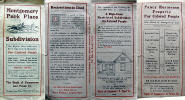 |
| |
|
|
|
This was
the first community in the south to allow African-Americans to be able to
own their own homes, and single families could also own their own property
in Orange Mound. |
|
|
|
|
|
|
|
|
|
|
Credits |
|
|
|
The
Historic-Memphis website does not intentionally post copyrighted
photos and material without permission or credit.
On
occasion a "non-credited" photo might possibly be posted because we
were unable to find a name to give credit. Because of the nature of
our non-commercial, non-profit, educational website, we strongly
believe that these photos would be considered "Fair Use. We have
certainly made no monetary gain, although those using this website
for historic or Genealogy research have certainly profited. If by
chance,
we have posted your copyrighted photo, please contact us, and we'll
remove it immediately, or we'll add your credit if that's your
choice. In the past, we have found that many photographers
volunteer to have their works included on these pages and we'll
also do that if you contact us with a photo that fits a particular
page. |
|
|
|
The "Historic-Memphis" website would like to acknowledge and thank the
following for their contributions which helped make this website
possible: Memphis
Public Library, Memphis University Library, Memphis Law Library,
Memphis Commercial Appeal, Memphis Press Scimitar, Shelby County
Register of Deeds, Memphis City Schools, Memphis Business Men's
Club, Memphis Chamber of Commerce, Memphis City Park Commission,
Memphis Film Commission, Carnival Memphis, Memphis Historical
Railroad Page, Memphis Heritage Inc, Beale Street Historic District,
Cobblestone Historic District, Memphis Historic Districts, Vance
Lauderdale Family Archives, Tennessee State Archives, Library of
Congress, Kemmons Wilson Family, Richard S. Brashier, Lee Askew,
George Whitworth, Woody Savage and many individuals whose assistance is
acknowledged on the pages of their contributions. Special
thanks to Memphis Realtor, Joe Spake, for giving us carte blanche
access to his outstanding collection of contemporary Memphis photos.
We do not have high definition copies of the photos on these
pages. If anyone wishes to secure high definition photos,
you'll have to contact the photographer or the collector.
(To avoid any possibility of contributing to SPAM, we do not
maintain a file of email addresses for anyone who contacts us). |
|
|
|
Historic-Memphis.com |
|
|
|
|
|








